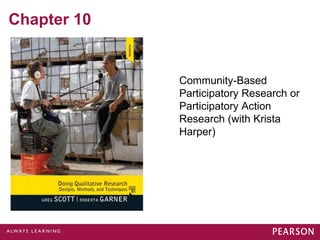Report
Share

Recommended
Recommended
More Related Content
What's hot
What's hot (20)
Astrosociology in the Classroom - 100 Year Starship Symposium 2013 - Jim Pass...

Astrosociology in the Classroom - 100 Year Starship Symposium 2013 - Jim Pass...
Creative research methods: Research using technology

Creative research methods: Research using technology
Kud ppt2.05.03.2018 Ethics in Research-Dr.Omprakash H M

Kud ppt2.05.03.2018 Ethics in Research-Dr.Omprakash H M
"New Research Shows" - or does it? Using ‘Junk Science’ in Information Litera...

"New Research Shows" - or does it? Using ‘Junk Science’ in Information Litera...
Intellectual honesty and research integrity abu saleh

Intellectual honesty and research integrity abu saleh
Similar to Garner c10
Similar to Garner c10 (20)
Giving direction to policies and manuals: high school journalism ethics

Giving direction to policies and manuals: high school journalism ethics
Dr Margo Greenwood (March 2017) Community- Based Participatory Research: A S...

Dr Margo Greenwood (March 2017) Community- Based Participatory Research: A S...
Engaging Online Through Community-Based Social Marketing

Engaging Online Through Community-Based Social Marketing
A strategic approach to policy engagement for research organisations

A strategic approach to policy engagement for research organisations
Public engagement with postgraduate research june 2013

Public engagement with postgraduate research june 2013
Building Research Partnerships for Public Health Impact

Building Research Partnerships for Public Health Impact
More from Beulah Heights University
More from Beulah Heights University (20)
Garner c10
- 1. Chapter 10 Community-Based Participatory Research or Participatory Action Research (with Krista Harper)
- 2. What Is CBPR? • CBPR breaks with the logic of the detached, objective observer in two ways: – (1) The researcher is trying to bring about change, and – (2) the researcher interacts & cooperates with the researched to bring changes the: • Researched themselves identified as desirable © 2013 Pearson Education, Inc. All rights reserved.
- 3. What Is CBPR? • A Brief History (or Rather, “Herstory”) – The Researcher As An Agent Of Change – The Community As The “Expert” – The Researcher Facilitates & Doesn’t Dictate • What Is the Meaning of “Community?” • Problem-Solving? Whose Problems, Whose Solutions? © 2013 Pearson Education, Inc. All rights reserved.
- 4. Par In Action: Environmental Justice In A Hungarian Village • Starting with Justice • Getting to Know the Roma • A Key Informant Emerges • Jointly Designing the Project – Photo-voice © 2013 Pearson Education, Inc. All rights reserved.
- 5. An Overview Of CBPR As A Design Choice • The researcher works with community leaders and the research is interactive; – In accord with egalitarian ideals • It is effective to use methods readily understood by community members and: – That are inherently engaging and participatory © 2013 Pearson Education, Inc. All rights reserved.
- 6. An Overview Of CBPR As A Design Choice • The production of information in a visual or physical form may be a more: – Meaningful product than peer-reviewed article published in a scholarly journal • The researchers must be willing to assume new roles as facilitators of: – Interaction within the community © 2013 Pearson Education, Inc. All rights reserved.
- 7. An Overview Of CBPR As A Design Choice • Interaction between the community members and the outsider is seen: – Explicitly not only as a way of beginning to address specific problems but, above all: • As a method of breaking isolation © 2013 Pearson Education, Inc. All rights reserved.
- 8. Practical Tips • CBPR and PAR require background knowledge of the community; – And contacts with community leaders • Try to establish multiple contacts and relationships in the community © 2013 Pearson Education, Inc. All rights reserved.
- 9. Practical Tips • Be patient • Develop methods of research and dissemination of the findings that will be: – Comprehensible and of interest to the community © 2013 Pearson Education, Inc. All rights reserved.
- 10. Par As Method And Object Of Teaching: Critical Perspectives • Careful preparation and a self-reflective approach to the limits of this design; – And the ethical and political concerns associated with it • A Retelling of PAR’s History • Revising the Definition of PAR © 2013 Pearson Education, Inc. All rights reserved.
- 11. Par and Pedagogy: The Politics Of Teaching & Learning Through CBPR • Beware the Backfire Effect: When CBPR Becomes the “Cure That Kills” – Objectification – Blaming The Victim – Paternalism • Often manifests in researchers’ and students’ verbal and nonverbal expressions © 2013 Pearson Education, Inc. All rights reserved.
- 12. Par and Pedagogy: The Politics Of Teaching & Learning Through CBPR – Identifying And Overidentifying With “The Other” – Disillusionment With CBOs • Community-based organizations – Pressure To Misrepresent © 2013 Pearson Education, Inc. All rights reserved.